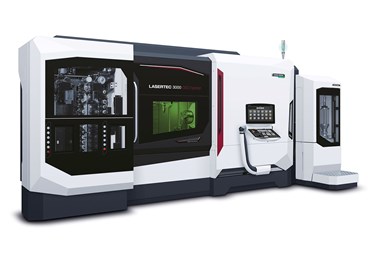Hybrid 3D Printer Offers Five-Axis Simultaneous Machining for Mold and Die Applications
DMG MORI’s Lasertec 3000 DED hybrid 3D printer offers process integration by combining laser deposition welding with five-axis, turn-mill machining in one setup.
DMG MORI’s latest hybrid 3D printer offers increased application possibilities by providing easier process integration and component potential for mold and die professionals. The Lasertec 3000 DED hybrid combines laser deposition welding by means of a powder nozzle and five-axis simultaneous machining — including turn and mill technology — in one workspace setup.
Thanks to the space-saving compactMaster spindle, the machine offers sufficient room for a wide range of components, so that mold builders, semiconductor, medical and aerospace sectors can use the hybrid machine for a variety of applications. With the combination of subtractive and additive manufacturing (AM) in one workspace, the machines are especially well suited for the production of prototypes and small series as well as in the repair and coating of components.
Simultaneous machining in three linear axes as well as in the C-axis and the B-axis is said to offer significant added value in the machining of even more complex workpieces. The compactMaster spindle functions as the B-axis, into which cutting tools or the powder nozzle head for AM can optionally be inserted. Even then, the length of the compactMaster spindle is only 550 mm.
The maximum component size is 400 × 1,321 mm with the B-axis at 90º. If this is rotated by 180º, component dimensions of 670 × 932 mm are possible. With a size of 6,876 × 4,510 mm, the Lasertec 3000 DED hybrid also requires the smallest footprint in its class, the company says.
The machine has a 3-kW laser that enables focus diameters of 3 mm and 1.6 mm. If the powder nozzle head is not needed, it can be stored in a separate compartment. This helps it remain free of metal chips.
On the software side, the AM Assistant supports AM. It enables better control of the coating process, such as monitoring the melting temperature and the distance between the melting point and the powder nozzle. An optical sensor also ensures reliable and automatic powder flow. Laser sensors on the machine cladding and windows, as well as a fog extraction system, also ensure a safe working environment.
Related Content
-
MMT Chats: 4 Keys to a Successful Mold-Building Operation: Innovation, Transparency, Accessibility and Relationship
MoldMaking Technology Editorial Director Christina Fuges chats with Steve Michon, co-owner of Zero Tolerance in Clinton Township, Michigan, about the excitement of solving problems, the benefits of showing gratitude, the real struggle with delegation and the importance of staying on top of technology. This episode is brought to you by ISCAR with New Ideas for Machining Intelligently.
-
From Injection Mold Venting to Runnerless Micro Molds: MMT's Top-Viewed June Content
The MoldMaking Technology team has compiled a list of the top-viewed June content based on analytics. This month, we covered an array of topics including injection mold venting, business strategies and runnerless micro molds. Take a look at what you might have missed!
-
VIDEO: How can 3D Printed Tooling Improve Injection Mold Venting?
Proper venting is one of a mold builders toughest challenges as molders struggle to keep vents free flowing in production. Learn how to apply 3D printing to mold venting and the benefits of additive venting inserts.
















_300x250 1.png;maxWidth=300;quality=90)
